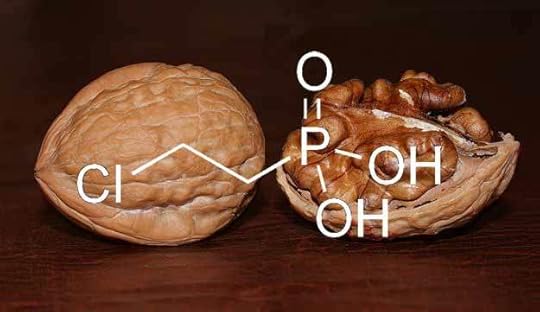Marc Abrahams's Blog, page 600
February 2, 2012
Nut loosening cracked in California
What strategies are available for walnut growers to loosen their nuts?
One possible method is provided by the Fruit and Nut Research and Information Center of the University of California at Davis. "A land-grant institution built to advance the human condition through improving the quality of life for all people of California, for all citizens of our nation and for the rest of the world." For nut loosening purposes they recommend (via their extensive Walnut Research Reports) the application of 2-Chloroethylphosphonic acid.
Comprehensive details of the university's techniques can be found here, here, and here.
Notes:
• The Walnut Research Reports are funded courtesy of the Walnut Marketing Board.
• Toxicological info. courtesy manufacturer Bayer CropScience
• Walnuts photo courtesy AndonicO / Wikpedia

Professor Snape Conjures Conjugates
Two truths:
Professor Snape is a character in Harry Potter novels.
Professor Snape conjures conjugate vaccines.
These are not the same Professor Snape. The second is likely sick unto death of hearing about the first. The first likely could not care less about the second.
 The second Professor Snape is Matthew Snape, MBBS, FRACP, FRCPCH, a Senior Research Fellow and Honorary consultant paediatrician at Oxford University (or as some call it, the University of Oxford). His photograph is reproduced here.
The second Professor Snape is Matthew Snape, MBBS, FRACP, FRCPCH, a Senior Research Fellow and Honorary consultant paediatrician at Oxford University (or as some call it, the University of Oxford). His photograph is reproduced here.
Professor Snape conjures up combination glyco-conjugate vaccines. Add Salt, and you get this study:
"Serogroup C Meningococcal Glycoconjugate Vaccine in Adolescents: Persistence of Bactericidal Antibodies and Kinetics of the Immune Response to a Booster Vaccine More Than 3 Years after Immunization," Matthew D. SNAPE, Penny SALT, et al., Clinical Infectious Diseases, (2006) 43 (11): 1387-1394.
(Thanks to investigator Ivan Oransky for bringing this to our attention.)
BONUS: The other Professor Snape #1:

Groundhog oscillation and Global Change
A look back at groundhog research we published in the year 2001. The study authors were at the time in Pennsylvania:
The Groundhog Oscillation: Evidence of Global Change
by Andrew J. Gerrard, Christina M. Gerrard, Mark A. London, Keith A. Soldavin, Timothy J. Kane and Alan Freed
There is a fierce debate about whether the earth's climate is changing. In this paper we describe an overlooked — but reliable — remote sensing instrument that can provide crucially pertient information. We also describe an extensive long-term data set that was obtained by using the instrument…[see the entire article]

February 1, 2012
Getting a LEGO up, on a dime
This video comes from a camera attached to a homebuilt device that rose to great heights. The Guardian describes it in a short paragraph (and also, elsewhere, in more detail):
Two teenagers from Toronto sent a Lego man carrying a Canadian flag into the stratosphere. Mathew Ho and Asad Muhammad, both 17, attached four cameras to a balloon carrying the toy astronaut 24km above Earth. A week after launch they recovered their Lego man in a field, and discovered they had captured stunning space footage
(Thanks to investigator Greg Johnson for bringing this to our attention.)

Headline of the Day: Cancer/Crab/Robot/Stomach
Today's Headline of the Day is from a Reuters report by Tan Ee Lyn. The headline manages to implicitly make both the mythic, astrological connection between cancer and crabs and the dietary connection between crabs and the stomach, and to include a trendy mention of robots (which are in fact the focus of the story):
Experts build crab-like robot to remove stomach cancer
The article goes on to say:
SINGAPORE | Feb 1, 2012 – Inspired by Singapore's famous chili crab dish, researchers have created a miniature robot with a pincer and a hook that can remove early-stage stomach cancers without leaving any scars….
They developed the robot after a seafood dinner in Singapore in 2004 with top Hong Kong surgeon Sydney Chung, who suggested they fashioned their device after the crab. Chung is best known for fighting SARS in Hong Kong in 2003.
"He (Chung) suggested we used the crab as a prototype. The crab can pick up sand and its pincers are very strong," said [enterologist Lawrence] Ho.
BONUS: How to cook crab in Hong Kong:
(HT Debra Sherman)

Bits of opera and science: twinkies, and the big bank opera
Two bits of opera/science pasticcio, sort of:
Hai-Ting Chinn sings the ingredients of a twinkie (the chemical constituents of an endangered American junk food):
Maria Ferrante sings the essence of the Big Bank Opera (how the financial crisis mirrored the birth of the universe):

January 31, 2012
Right Bias in Tortoise Righting
If one were to overturn a tortoise, would it be more likely to right itself (i.e. get back on its feet) to the right or to the left?
 To find out, a joint research team from the Comparative Psychology Research Group, University of Padova, Italy and the B.R.A.I.N. Centre for Neuroscience, University of Trieste, Italy, performed a unique set of experiments with 34 overturned tortoises.
To find out, a joint research team from the Comparative Psychology Research Group, University of Padova, Italy and the B.R.A.I.N. Centre for Neuroscience, University of Trieste, Italy, performed a unique set of experiments with 34 overturned tortoises.
"Each trial consisted of overturning a tortoise (about its sagittal axis) and gently placing it on the above described apparatus. [The test apparatus consisted of a plastic arena 38.5 cm × 29cm × 15 cm high filled with sand up to 2 cm from the top.] Before of each single test the layer was levelled evenly. The righting response was video-recorded and the direction of righting was scored. After completing each response the tortoise was free to rest and walk around for some minutes before being administered a next righting trial."
The experiments revealed a distinct bias in the tortoises' righting behaviour – for reasons which are, as yet, poorly understood.
"A bias at the individual as well as at the population level was found for preferentially turning on the right side."
'Lateralized righting behavior in the tortoise (Testudo hermanni)' is published in Behavioural Brain Research, 173: pp. 315-319.
Notes:
• All tortoises successfully completed the righting procedure within 2 minutes.
• No invasive procedures were used. Tortoises' experimental and housing conditions were in accordance with the Italian and European Community laws on protected wild species (Art. 8/bis 150/92 all. A Reg.(CE) 338/97).
Queries:
• Would the results have been different if the tortoises had been overturned about another axis – e.g. the coronal axis or transverse axis?

January 30, 2012
Cereals with that patented chameleon quality
 When parents warn children not to play with their food, there's now reason to add a menacing "even if": "even if the food begins playing with you". Recently, food was given a new ability to play, a little, the moment it encounters milk.
When parents warn children not to play with their food, there's now reason to add a menacing "even if": "even if the food begins playing with you". Recently, food was given a new ability to play, a little, the moment it encounters milk.
Researchers have patented a way to make breakfast cereal change colour as it sits in the bowl, awaiting its roller-coaster ride down somebody's throat.
The patent documents explain why the world needs this to occur, as well as how, chemically and mechanically, to do it.
Hideo Tomomatsu of Crystal Lake, Illinois, filed a patent application in 1987 for what he called "colour-changing cereals". Eight years later, Joseph Farinella of Chicago, Illinois, and Justin French of Cedars, Iowa, used much of the same stilted wording in filing their own application. Both patents were granted, with the rights being assigned to the Quaker Oats Company….
So begins this week's Improbable Research column in The Guardian.

Math Exercise: Count the REPETITION
This week's Math Exercise is: Count how many times the word "repetition" appears in the following text. The text is the citation for a published academic study:
"Importance and Need of Reconsidering Rhetorical Repetition," Sabzalipour Jahandust [pictured here], Journal of Faculty of Letters and Humanities (Tabriz), Fall 2009-Winter 2010; 52(211):81-103. The author, at Rasht Azad University, writes:
There are numerous references to repetition or "TAKRIR" in rhetorics. For repetition, various motives and types have been enumerated. In these cases, frequency of repetition was considered to distort eloquence, and proper repetition was regarded to be of significance and fruitful. Most scholars are of the opinion that repetition in Quran is not only proper but also miraculous.
The present study aimed at investigating the importance of repetition through reviewing numerous texts. Also, this paper sought to study repetition in Persian language and literature and its importance. The findings revealed that repetition, not only in colloquial language but also in literary language, can be viewed as having an asthetic nature in composing poetry and creating a piece of art.
The main parts of this article are: definition of repetition, motive of repetition, human an's interest in repetition and kinds of repetition. The type of repetition that was studied here is not repetition in terms of phoneme or morpheme but it is repetition in phrases and sentences and at discoursal level.
BONUS: The importance of repetition.

Exciting Video: Methodology Options
It's time for still another visit with Nigel Bradley.
This is the most exciting video you will have seen during the minute and two seconds you were watching it. It's specially made for market researchers. It's called "Methodology options available to the researcher". It's from Oxford University Press. It's right here:

BONUS: All about the star: Nigel Bradley

Marc Abrahams's Blog
- Marc Abrahams's profile
- 14 followers
























